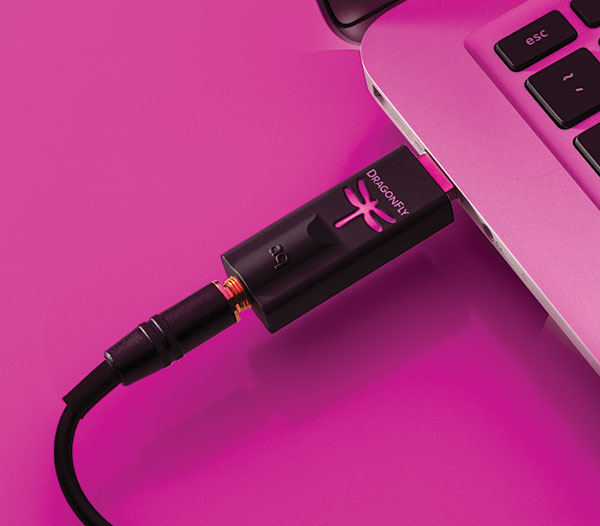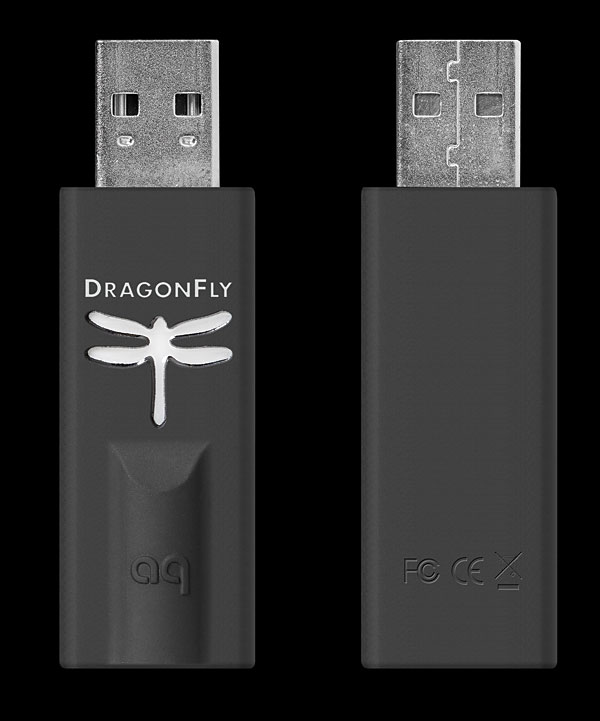| Columns Retired Columns & Blogs |
Dudley reviews a $249 DAC with a $1395 cable. Makes sense to me!
A word about volume controls: Those who've used the above-mentioned Wavelength Proton, or who've read my review of same, may recall the designer's recommendation to avoid setting the volume control on the associated computer to 100%: The Proton's integral analog control works in 1dB steps from –80 to +6dB, but that last 6dB is really meant for driving headphones. The DragonFly's analog volume works similarly, in 64 steps—yet Gordon Rankin has designed it to have 60 steps up to 0dB, max. Consequently, the DragonFly owner can set the computer volume at 100% without fear of distorting the signal at that stage.
That line-amp setting, intended by Rankin to reduce asymmetrical clipping at maximum output, represents a slight change from the very first production units of the DragonFly, which included my review sample. Before submitting this review I received a current production sample and compared the two: Such differences as I could hear were vanishingly slight—to a degree I would associate with sample-to-sample variances in the same product, in fact. At the end of the day, I couldn't identify which was which, the two DragonFlys having very much the same sonic character and overall musical quality.
Listening
Although the DragonFly's performance gained some textural refinement during the review sample's first few weeks in my system, its performance was very engaging from the start. Dynamically bolder and timbrally more vivid than most contemporary DACs of my acquaintance, the DragonFly's sound was colorful and up-front. Tonal balance, from bass to treble, was as good as I've heard in a modern digital source component, being neither dull nor overly crisp or bright. Spatial performance was good, with notably fine stage width and a consistent ability to suggest whatever hall sound or "air" might have been present on each recording.

Once settled in, the DragonFly also excelled at capturing the tones of acoustic instruments (footnote 2). Peter Wispelwey's cello in Bruch's Kol Nidrei (AIFF file ripped from CD, Channel Classics CCS SA 16501) sounded colorful and exceptionally well textured: The solo instrument thrummed believably, and the double basses of the German Chamber Philharmonic Bremen (led by Daniel Sepec) gave, in my humble room, a pleasant semblance of the way those instruments might have loaded the space in which they were recorded. Similarly, the double bass, mandolin, and acoustic guitar in the version of McCoy Tyner's "Search for Peace" performed by Phillips, Grier & Flinner on their Looking Back (AIFF ripped from CD, Compass 7-4342-2) was startlingly good. This digital recording has never sounded better on my system—especially true of the many languorous slides played by bassist Todd Phillips, which combined superb texture and color with richly perfect sustain and very sharp timing.
Comparisons
As John Atkinson suggested in his review of the Halide DAC HD USB DAC (August 2012), an inexpensive product must be judged in the context of its peers. So it went with the AudioQuest DragonFly, whose size and construction invited comparisons with the Halide, the birthright of which fairly obligates comparisons with the Wavelength Proton.
Take the last first: Distinctions between the DragonFly and my own Wavelength Proton DAC were not as I expected. With Neil Young's "Out On the Weekend," from the high-resolution download of Harvest, the DragonFly had somewhat better treble extension, giving Young's voice and, especially, the guitars and drums noticeably better openness and presence. Additionally, the snare drum, heavily compressed though it is (and unrealistically jailed in the left speaker, for that matter), seemed to have more impact through the DragonFly.

But: In the months after my having reviewed and, soon after, purchased it, the Proton had settled into a more domestically acceptable setup, with a 1m USB cable and a very long (+8m) interconnect pair between converter and preamp. Wondering if that accounted for the slight, relative dullness of the older converter, I temporarily moved the desk on which my computer sits in order to give the Wavelength Proton a 2m interconnect, while preserving the short USB cable. That restored some measure of treble extension and consequent presence and openness, yet the DragonFly still sounded slightly more brilliant, even with its 5m interconnect: the only one at my disposal that had a 3.5mm plug.
Furniture remained in disarray long enough for me to compare the DragonFly with the Halide DAC HD, which JA kindly forwarded to me. (Stereophile's review sample of the HD came hardwired with a 2m interconnect pair terminated with Bullet Plugs.) I was very impressed with the Halide—which, while sounding no more colorful than the DragonFly, presented those timbral colors in a more sophisticated manner, with subtler and more complex gradations between different sounds. The Halide also had more spatial depth with stereo recordings. In other words, the more expensive converter sounded like a more expensive converter, while at the same time tarnishing not at all the humbler product's extremely good performance and value.
Conclusions
Although AudioQuest's first D/A converter appears to be aimed at non-audiophiles, most of whom will almost certainly use it with Apple iTunes, the DragonFly sounded more than good enough to expose and exploit the performance differences between Apple's giveaway player on the one hand, and various perfectionist-quality music players on the other. One might see that as an irony, but I see it as an opportunity: With a bit of luck, we'll have those people smearing Peter W. Belt Cream Electret on the frames of their glasses in no time (footnote 3).
Thanks to the miracle of editing, Steve Silberman returns now to his theme: "High-end audio can continue to make the products they make: They don't have to go away. But we also have to think outside of the box." I agree, on both counts.
The people who ran right out and bought the first Compact Disc players wound up with egg on their faces and junk on their hands. Those ca-$1000 players of 1983, which sounded as wretched as they were rapaciously priced, were surpassed with a speed and a surety that, among other things, guaranteed that there would never, ever, in the history of the universe, be such a thing as a market for vintage CD players.
The audio industry has since learned a great deal. (One might hope that the reviewing community, members of which reacted to digital audio as Southern belles swooning in the presence of Ashley Wilkes, might also have tightened up their act over the last three decades.) In the computer-audio world, progress also endures—not to the detriment of the first USB D/A converters, which remain enjoyable on the basis of their very real strengths, but to the advantage of the consumer. The fact is, the $250 AudioQuest DragonFly sounds at least as good as my $900 reference converter. It's also unobtrusive, and its design eliminates the need for a separate and potentially expensive USB cable: an especially laudable move for a cable company with no small interest in selling same. Perhaps best of all, the DragonFly is fun: It's a thumb in the eye of those tea-pinky tyrants who would tell the rest of us what is and is not high end. I can think of no more recommendable product in digital audio.
Footnote 3: To say nothing of the effects of our unrelenting liberal bias.

Dudley reviews a $249 DAC with a $1395 cable. Makes sense to me!

Please note that the Dragonfly, being powered solely by the USB port of the computer, is VERY sensitive to the quality of the USB power being supplied. I used my Dragonfly on a laptop with a completely dead battery. While in use, the wall AC-charger had to be plugged in or the computer wouldn't even boot.
The system sounded SO BAD with the Dragonfly, that I replaced speakers (twice) before noticing that the Dragonfly was the problem. I probably could have solved the problem with an external USB "powered hub," but I sold the Dragonfly before thinking of that.
Bottom line is - For the Dragonfly to perform at its best, the computer MUST supply sufficient voltage and a sufficiently clean DC voltage via its USB port. If not, then the Dragonfly sounds absolutely atrocious! If you have ANY doubt about the quality of the power to your computer's USB ports, then buy a good quality powered USB hub and be prepared to be AMAZED at the sound quality difference!
Boomzilla

Stoner Acoustics, a bare-bones start-up from Malaysia, has a few very low cost DragonFly-like DACs that seem to use high-quality parts (such as ESS Sabre DAC, etc.). A decent review is on head-fi.org here:
http://www.head-fi.org/t/626632/tiny-dac-big-sound-evolved-impression-of-stoner-acoustics-ud100-ud110
Stoner Acoustics' web site is:
http://stoneracoustics.blogspot.com
Some photos ...
And it seems to be Android friendly:

Just had a demo of the Audioquest Dragonfly v1.2 DAC with my favourite headphones, notice this cool looking point of sale featuring the Dragonfly too :-)


I've recently purchased the v1.2 and noted severe clipping/distortion when plugged into my Macbook Pro USB and run directly to my Sony MDR-7506s. (Most apparent with lossless files at mid-hi volume; listening to James Blake was a nightmare). Thought the 7506 would be low enough impedance (63 ohms), but was surprised and disappointed to find out the v1.2 wouldn't drive them. Ran the v1.2 through my old Tandberg TR2045 amp's headphone jack and through my NHT SuperOnes and they sounded fantastic.
Hoping it's something I'm doing wrong and not a shortcoming of the Dragonfly v1.2, but I'm not sure what else it may be.

I use a V2 Dragonfly and for $149 it cannot be beat